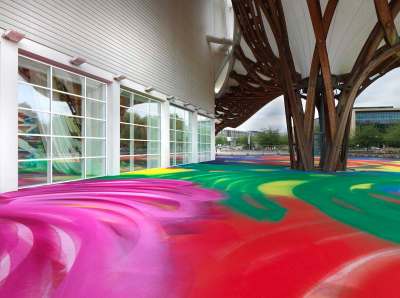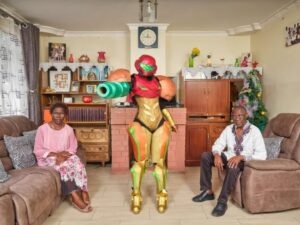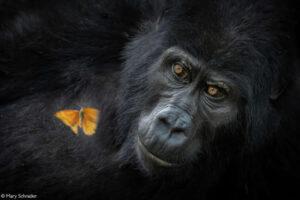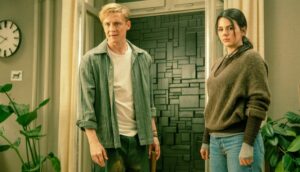Ahead of Art Basel, Katharina Grosse Sprays the Messeplatz with Color

Over the past 40 years, German artist Katharina Grosse (b. 1961) has gained many fans for using an airless spray machine to make eye-catching, color-saturated, and immersive paintings. Many of her works have been shown in museums and galleries—one from 2004 involved spraying paint across the Contemporary Arts Museum Houston’s interiors, along with clothing, papers, eggs, and coins scattered across the floor—but she has also created site-specific installations for less conventional places, including an abandoned military building in New York’s Fort Tilden Park.
This week, Grosse will take on one of the biggest projects of her career: a monumental painting that will fill the Messeplatz in Basel during the Swiss edition of Art Basel. Titled CHOIR and curated by Natalia Graboska, the project will see her spray paint the entirety of this pedestrian precinct in shades of magenta.
ARTnews spoke with Grosse about the evolution of her practice and her plans for this year’s iteration of Art Basel.
ARTnews: You were introduced for the time to a spray gun in Marseille. What was so enticing about it?
Katharina Grosse: I was in Marseille for half a year in the 1990s. It was a very anarchic place, much more so than it is now. I got to see people work with spray guns and other tools. I only tried out a spray gun a few years later. [The people in Marseille] saw themselves as outsiders. The atmosphere there definitely changed my approach to painting.

Katharina Grosse, Déplacer les étoiles, 2024.
Photo Jens Ziehe/Courtesy Centre Pompidou – Metz; Gagosian; Galerie Max Hetzler; and Galerie nächst St. Stephan Rosemarie Schwarzwälder/©2025 Adagp, Paris
Edvard Munch experimented with spraying devices to paint during the 1890s. Was he one of your inspirations?
I did not have this reference, no. However, I have always been attracted to Munch’s work, especially because he was doing unusual things with his paintings, taking them off stretchers and hanging them off a hook in the snow. His outdoor studio is fascinating to me. His works had no beginning no end, which I can relate to because, to me, a painted image is not limited to a canvas. I traveled to Norway around 1985 to see where Munch lived and the landscapes he drew inspiration from. I am currently preparing a show that will open in 2026 at the Munch museum in Oslo.
How has your technique evolved since you spray painted a corner of one of the Kunsthalle Bern’s galleries in green, then realizing that painting “could pass over architectural structures and borders”?
Untitled [a 1998 work that involved spraying acrylic paint directly onto the corner between two walls and a ceiling at the Kunsthalle Bern] was a key moment in my career. It made me understand the independence of painting, which doesn’t have to comply with spatial rules. It’s almost like an exterior agent that swoops in, flickers up, shows possibilities we hadn’t seen before, makes them more complex and then, all of a sudden, wears off and disappears. Another turning point for me was The Bedroom. In 2004, I painted over my bedroom, including personal objects—books, sheets, works that I had made in the past, pieces of furniture. It did not feel like a loss, but rather like a transformation. It gave me another perspective on my life. Now, when I’m invited to paint in a public space, I draw from that experience. I see it as a crossover. I put a painted image—which is a proposition, part of my imagination—on top of something that everybody knows.

Katharina Grosse, Rockaway, 2016.
Photo Pablo Enriquez/©2025 VG Bild-Kunst/Courtesy MoMA PS1
The same kind of crossover will happen on Messeplatz, which Art Basel has commissioned you to paint entirely before the beginning of the fair.
It’s the first time that a painter has been invited to take over the 53,800-square-foot Messeplatz. The challenge with that piece is that I have to be up to that scale. My movement determines how the place is being perceived. The spray gun will help me expand my reach. With this tool, I can paint endlessly. Then, I will go over the whole square—into the water, over the water, over the roofs that are in front of the entrance.
Fair-goers are transient. Once they step into the Messeplatz, they will become part of the work. I really want to create a painting that is almost like a threshold between reality and fiction. It is a membrane: you can walk through it, step out of it at any time, or stay in it as much as you want.
How will you do that?
I want to make a visceral painting that gets into your system so fast that you don’t have to think about it. In that prospect, I’ve worked working with photographs, floor plans, models of various scales, but with a clear vision in mind. [The idea] popped into my head right away—which is not always the case.
The square is being protected by a very thin layer of asphalt that will be peeled off and recycled once the fair is over. I usually don’t paint on black, so we’ll have to create a white structure for me to paint over. I chose two tones of magenta for their high visibility. This is the color that lifeguards now use instead of orange.
How do you feel about your work being ephemeral?
I like the idea that my work will disappear after seven days, once Art Basel is over. You can’t buy it, you can’t own it. It defies the reality of the fair, which is mainly about transactions. There is beauty in that transience.

Katharina Grosse, It Wasn’t Us, 2020.
Photo Jens Ziehe/Courtesy König Galerie, Gagosian, Galerie nächst St. Stephan Rosemarie Schwarzwälder, Staatliche Museen zu Berlin, Nationalgalerie/©2025 VG Bild-Kunst, Bonn
Your exhibition at the Deichtorhallen Hamburg features an installation and a selection of studio paintings, as well as drawings and sketch books. What does working indoors bring you that performing outdoors does not? And vice versa?
Working outdoors is almost like swimming in the sea; and indoors, like swimming in a pool. There are two different ways to do it, and yet, you’re still in the water. In my studio, I can be working on 20 to 30 works at the same time. My approach to color is then more experimental. Otherwise, I use it to come into an area which escapes labels, definitions, and descriptions, to feel a direct resonance with a space I am connecting with.
You are known for embracing the events and incidents that arise as you work. What kind of incidents could occur during the creative process?
I don’t expect anything, and that’s the point. In my experience, I start with what I have envisioned, to get a sense of the space and atmosphere I am working with, but I am still aware that many things may impact my work—the wind, the weather, my team. After a while, you become part of the painting, which makes it easier to adapt and find solutions. You resonate with everything and everybody you work with, like an organism.




